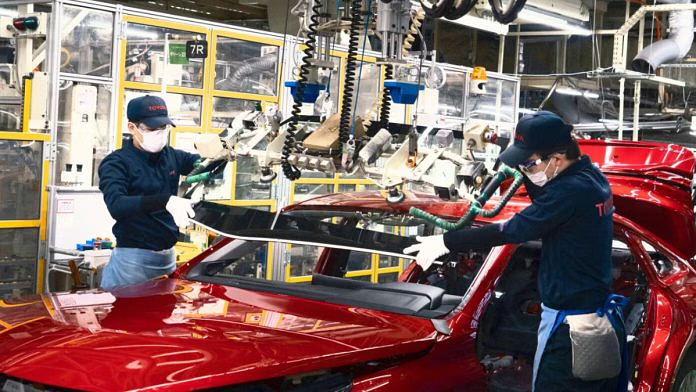In ‘Atypical’, Prateek Raj provides a forward-looking blueprint for leaders who envision a more inclusive, sustainable, and resilient future.
Where do the capabilities of organisations lie? Let us take a look inside organisations to answer this. All stakeholders, even those within an organisation, have unique needs, wants, desires, issues and asks. The unique incentives and concerns of an organisation’s stakeholders can create a social dynamic of either cooperation or conflict, shaping how effective organisations are in producing process improvements and product innovations, which lie at the heart of successful organisations.
The Worker-centrism of the Toyota Production System
Consider you are the manager of an automobile manufacturing plant. You interact with the various stakeholders of the plant, such as the line worker, production manager, supplier, and so on. All of these can have different concerns. A line worker who finds a pattern that might lead to defects in the product may face a dilemma—should they raise the alarm and stop production? The worker may wonder: ‘Should I raise the alarm when I see a problem, or will I be blamed for raising concerns about trivial things and causing losses?’ A production manager who sometimes responds to false alarms may wonder: ‘Are issues raised by workers sincere concerns, or are these tactics to cut corners and be less productive?’
Similarly, a supplier has to decide whether to dedicate their resources fully to a large automobile manufacturer or to serve multiple businesses. They may wonder: ‘Can I invest in a long-term relationship with this particular manufacturer, or should I explore alternative options, just in case?’ An HR person at the company may similarly wonder: ‘Whose demands are more legitimate—the management’s efficiency objectives or the issues raised by workers?’
As the manager, how can you manage the different concerns in your manufacturing plant? A delicate balance of trust is at the heart of even the most massive and efficient engineering systems like the legendary Toyota Production System (TPS). At the heart of TPS and its lean manufacturing philosophy is Kaizen or ‘continuous improvement’, which rests on the ability of all employees, most importantly line workers, to identify defects and stop the line if they spot potential errors. Any worker can stop the production line when they spot an error so that defects do not flow across the entire production line.
Workers at Toyota factories are empowered to be hands-on problem-solvers in the factory line, continuously improving the processes by themselves and not waiting for a supervisor’s permission. The father of the Toyota Production System, Taiichi Ohno, summarised this philosophy of worker-driven continuous improvement by saying, ‘Something is wrong if workers do not look around each day, find things that are tedious or boring, and then rewrite the procedures. Even last month’s manual should be out of date.’
For such a system to work, supervisors must trust the workers that the concerns they raise are genuine and not excuses. There must be a culture of ‘respect for people’ from the top to the bottom of the organisation’s hierarchy. Continuous improvement and respect for people are the two pillars of the ‘Toyota Way’, considered the most legendary manufacturing system of the twentieth century.
The Toyota System works when this trust works, and stakeholder beliefs and norms are aligned. The Toyota line worker does not worry if the supervisor will question their motives, and a supervisor feels confident that line workers will raise alarms sincerely. Similarly, suppliers feel confident investing in long-term processes dedicated to serving Toyota, which helps the company maintain zero inventory of components and minimal delivery time from suppliers, keeping the manufacturing plant lean. Similarly, HR does not feel a tension between the management’s goals and workers’ concerns, as the management’s stated and sincerely held approach, the Toyota Way, is to listen to those doing the production. Genuine emphasis on harmonious and trustworthy relationships is the key.
When this trust between different stakeholders crumbles, systems malfunction too. Maintaining this balance is one of the managers’ most challenging tasks, because such trust does not emerge through written contractual arrangements but through the long-term nurturing of a culture where all stakeholders understand their roles and expectations and feel fairly treated and heard.
We call such tacit aspects of exchange relationships relational contracts, which work through uncodified norms and beliefs. Exporting these norms and beliefs from one place to another is complex, so even the best-designed systems may fail when established in the wrong place. Capabilities of businesses are often embedded in these relational contracts between different stakeholders of the business.
Apple’s Collaborative Culture of Innovation
Developing or acquiring capabilities is a challenging task for businesses. Like process improvements in manufacturing systems, product innovation at companies like Apple also rests on the ability of various stakeholders to trust each other so that ideas can be exchanged without hesitation, promoting collaboration, which is at the heart of innovation.
The Investment Dilemma
Almost every relationship, at a given time, has trust asymmetry—where one party (principal) must trust while the other party (agent) must be trustworthy. In such situations, the common (equilibrium) outcome tends to be where the principal cannot trust the agent, and hence, no investment gets done, leading to lost opportunities. When such relationships can be repeated between the same principal and agent, trust and no trust can be potential outcomes depending on how players play the game. Relational contracts are an understanding where the principal and agent establish trust through a repeated history of cooperation.
A junior engineer at an R&D institution may not be willing to trust their superiors if they believe their ideas will not be rewarded in the organisation, or worse, will be stolen by someone else, who will take credit for them.
Many innovation cultures get ruined by mistrust, where juniors cannot trust their seniors to give them the due credit for their efforts. Hence, in such dysfunctional systems, ideas are not exchanged.
It takes time and a repeated history of trust and trustworthy behaviour for a stable ecosystem to emerge, where various stakeholders can trust and be trustworthy to each other. In such stable ecosystems, stakeholders can invest in creating inimitable business capabilities.
Consider Apple and its ability to create innovation at scale. Apple co-founder and former CEO Steve Jobs said about its innovation culture, ‘We’re paying people to tell us what to do. I don’t view that we pay people to do things. That’s easy—to find people to do things. What’s harder is to find people to tell you what should be done.’ A culture that values a bottom-up idea generation leads to flat organisational structures, the hallmark of modern innovative companies.
Such a culture of collaboration sharply contrasts with many hierarchical organisations where the writ of egoistic managers runs large. Such hierarchical organisations may not be in a position to drive serendipitous innovation. However, hierarchical organisations, like space agencies, may still be able to deliver well on well-specified innovation missions.
Tim Cook on Apple’s Culture
Apple’s CEO Tim Cook in 2013, delving deeper into Apple’s culture of collaboration, said:
You look for wicked smart people. You look for people who appreciate different points of view. People who care enough that they have an idea at 11 at night and they want to call and talk to you about it. Because they’re so excited about it, they want to push the idea further. And that they believe that somebody can help them push the idea another step instead of them doing everything themselves.
I’ve never met anyone in my life, maybe they exist, that could do something so incredible by themselves in companies with global footprints. In our world, in Apple’s world, the reason Apple is special is we focus on hardware, software, and services. And the magic happens where those three come together.
And so, it’s unlikely that somebody that’s focused on one of those in and of itself can come up with magic and so you want people collaborating in such a way so you can produce these things that can’t be produced otherwise. And you want people to believe in that.
If a business attempts to replicate Toyota’s manufacturing system or Apple’s innovation capabilities, they must first replicate the relational contracts that underpin these organisations. In these contracts, a unique history and social dynamics have enabled these businesses to create environments where stakeholders feel incentivised to invest in developing new process or product innovations.
Even if Toyota or Apple wrote a detailed handbook on how they worked, their systems may not be replicable simply because the historical and cultural context may differ from one organisation to another. Each organisation would have to figure out its own way. How can organisations develop their own unique ways in which trustworthy relationships can be established between different stakeholders? The Tatas can show the way.
Source:






















